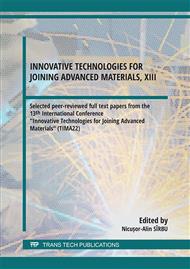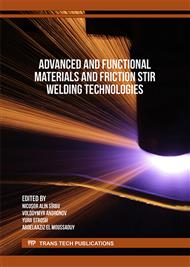p.121
p.131
p.143
p.155
p.163
p.175
p.185
p.193
p.205
Fracture Characteristics of EN AW 1200 Tensile Test Specimens Joined with FSW and SFSW Processes
Abstract:
The aim of the current study is to perform a preliminary analysis on specimens extracted from 4 mm sheets of EN AW 1200 alloys that were butt-joined using FSW and two SFSW processes. The purpose of this scientific investigation is to promote the suitability and advantages of new ecological joining processes by implementing SFSW in the automotive, naval, railway and aerospace industry. The papers authors performed destructive testing on specimens extracted from sheets joined with the above mentions processes, namely tensile strength test according to SR EN ISO 6892-1:2020. Researchers also performed topography analysis on samples extracted from the AW 1200 but-joined similar sheets using scanning electron microscopy – SEM, combined with energy dispersive X-ray analysis EDAX. Results from the tensile tests highlighted an improvement in the ultimate tensile strength of the welded butt-joint, if compared to regular FSW results. The highest tensile strength value resulted from the samples extracted from joints performed using the second version of SFSW process. Researchers also noticed that samples broke in the weld or transition area. There was also a change in the chemical composition of the sample performed using the first SFSW method, namely, a high concentration of oxide appeared (≥18%), leading to the conclusion that the module used induces rapid oxidation of joints. Experimental data doesn’t comply with automotive, railway, naval and aerospace-imposed compliances, thus further investigations should be done to improve the application of the technology.
Info:
Periodical:
Pages:
163-173
Citation:
Online since:
August 2023
Price:
Сopyright:
© 2023 Trans Tech Publications Ltd. All Rights Reserved
Share:
Citation:



